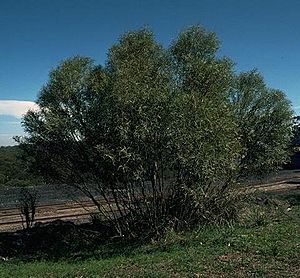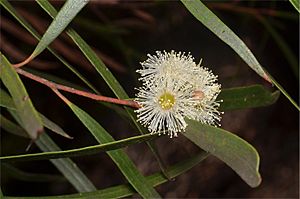Narrow-leaved mallee ash facts for kids
Quick facts for kids Narrow-leaved mallee ash |
|
|---|---|
 |
|
| Eucalyptus apiculata habit | |
| Scientific classification | |
| Genus: |
Eucalyptus
|
| Species: |
apiculata
|
| Synonyms | |
|
Eucalyptus laophila L.A.S.Johnson & Blaxell |
|
The narrow-leaved mallee ash (Eucalyptus apiculata) is a special type of mallee tree. It is found only in New South Wales, Australia. This means it is endemic to that area.
This tree has smooth, light-colored bark. Its leaves are long and thin, like a spear. It grows white flowers in small groups. After the flowers, it produces fruit that looks like a small pot or barrel.
Contents
What Does the Narrow-Leaved Mallee Ash Look Like?
The narrow-leaved mallee ash is a mallee. This means it is a type of eucalyptus that grows many stems from its base. It usually looks more like a large shrub than a tall tree.
Bark and Leaves
Its bark is smooth and can be white or grey. When the tree is young, its leaves grow in pairs. These young leaves are long and narrow. They can be up to 16 centimeters (about 6 inches) long. Both sides of the leaves are shiny green.
As the tree gets older, its leaves change. Adult leaves are also narrow and spear-shaped. They are shorter, usually between 3.5 and 11 centimeters (about 1.4 to 4.3 inches) long. Each leaf has a small point or hook at its tip.
Flowers and Fruit
The flowers of the narrow-leaved mallee ash are white. They grow in small groups of three to seven buds. These groups grow on a short stem called a peduncle. Each flower bud also has its own tiny stem, called a pedicel.
The flower buds are oval or club-shaped. They have a cap on top called an operculum. This cap protects the flower before it opens. The cap also has a small point on its tip.
This tree flowers between October and March. After flowering, it produces fruit. The fruit is a capsule that looks like an urn or a barrel. These fruits are about 6 to 9 millimeters (about 0.2 to 0.3 inches) long.
How Was This Tree Named?
The narrow-leaved mallee ash was first officially described in 1902. Two scientists, Richard Thomas Baker and Henry George Smith, gave it its scientific name. They wrote about it in their research paper.
The scientific name is Eucalyptus apiculata. The word apiculata comes from Latin. It means "with a small point." This name refers to the small point found on the tips of the tree's leaves.
Where Does This Mallee Ash Grow?
The narrow-leaved mallee ash is a rare plant. It only grows in a small area of New South Wales. You can find it between the towns of Linden and Berrima. It prefers to grow in mallee shrubland areas. These are places with many multi-stemmed eucalyptus trees and shrubs.



